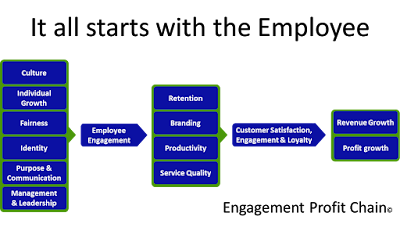To create satisfied customers doesn’t really make you
successful anymore – apart from creating value you also need to engage your
customer to grow your revenue.
Customers are not just looking for the same product or
service they have only cheaper or with an extra feature – they are looking for
something radically useful or something that creates meaning for them.
Every market matures and in every mature market the
product/service looks more and more alike. It will be based on the same
technology made on the same factory or delivered after the same principles. Not
much room for differentiation other than price that shrinks the pie for all
market players. All products will eventually satisfy customers but not necessarily
engage them.
To engage customers you will need to go beyond the product
or service itself. It is not about what you do, it is about why you do it and
how you do it.
"Always start with why" Simon Sinek
Customer engagement is an emotional relation between the customer
and one or more actors associated with the company. It is certainly possible to
create an emotional relationship between a customer and a product/service brand
as is seen with luxury items and cars; however this is not possible in most
markets.
Relationship with the product itself
When products and services become more alike it becomes more
important how it is made and what the overall purpose of the producing company
is. It is not anymore about transactional selling but more about a relationship
and eventually being part of a movement.
Relationship with the company
Customers don’t buy from you just because you want a lot of
money but they might want to buy from you if your company is trying to support
society or making the world a better place. The low priority of CSR in many companies,
will not work in the future. It does not inspire customers or employees. The new
hyper growth companies predominantly from the US, all has a strong purpose in
the centre of their activity. Google, Apple, Tesla, Facebook and similar are
not in the business just to make money – they want to make a difference also. This
engages not only employees but also customers.
Relationship with touch points
The rise of the internet and social media has made many
companies forget that their employees are vital in creating engagement with
customers. Unfortunately only 13% of all employees worldwide are engaged and
hence capable of creating customer engagement. The service aspect has also
been neglected even though there is a higher probability in creating an engaged
customer through a service issue than there is through a normal successful delivery.
The massive advertising on social media that looks the same
as the old newspaper advertising can create awareness but is not successful in
creating engagement. Most companies miss the point of having their senior managers’
active on social media (Only 28% of CEO has social media accounts). CEO’s have
an opportunity to engage in conversations about purpose and sustainable
production that can catapult engagement. Leaders like Tim Cook (Apple), Elon
Musk (Tesla) Eric Schmidt (Google) are all very active in engaging both
customers and employees.
Relationship with other stakeholders
The most important consumer buying decisions are heavily
impacted by people close to the consumer and different interest groups. You
cannot ignore Greenpeace, Amnesty international or trade unions anymore. The
company need to include all stakeholders into their strategy formation and make
it transparent. A transparent company does not need to hide behind a brand.
The link between Employee and Customer engagement
Gallup has shown that there is a strong relationship from
Employee Engagement over customer engagement to financial results. Companies
that manage to engage both customers and employees have 240% better results on
performance related parameters.










